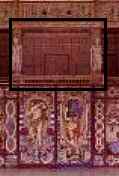"Above" and "below"
Juliet speaks to Romeo from what we are accustomed to call her "balcony"; Richard II appears on the walls of Flint Castle to parley with his challenger, Henry Bolingbroke. In each case, the vertical distance between the actors is figured in the language Shakespeare uses.
Romeo compares the light in Juliet's "window" to the rising sun:
But soft, what light through yonder window breaks?
It is the east, and Juliet is the sun.
(2.2.2-3)
There is no stage direction in the original texts to indicate that Juliet is "above" when she later enters; as is often the case, the text provides clues that the originals failed to record. Also, Juliet does not appear at the romantic balcony, but rather at a simple window.
Richard compares himself to the legendary Phaethon as he comes down from the wall (the upper stage) to the "base court," a lower courtyard in the castle (the main acting area of the stage).
Northumberland: My Lord, in the base court he doth attend
To speak with you; may it please you come down?
Richard: Down, down I come, like glistering Phaethon,
Wanting [lacking] the manage of unruly jades.
In the base court? Base court, where kings grow base,
To come at traitors' calls and do them grace. (3.3.176-81)
Just how these scenes were staged is still debated. It is clear that there was some space available above the stage for action "above," but it does not seem to have been extensive*, and it is quite surprising how seldom Shakespeare uses the space.
What was the trapdoor in the stage used for?*
The function of the balcony is discussed on the site of the New Globe Theatre.
Footnotes
-
How much room for action above?
In several of his reconstructions of the Elizabethan stage, C. Walter Hodges proposes that there was a structure that projected above the main acting stage, like a "house" in the Court drama. This suggestion has not received wide support.
-
Action below the stage?
In Hamlet the Ghost "cries under the stage" when it asks Hamlet's friends to swear secrecy; later the Gravediggers dig a grave somehow on stage, producing at least one skull for Hamlet to meditate upon.
Though Shakespeare makes sparing use of it, most theaters had a trapdoor in the middle of the stage, which could be raised or lowered as needed. The entrance thus created could be used to represent such things as a cave, grave, or well. In revivals of older morality plays, the trapdoor could have represented Hell Mouth.
One contemporary image of the stage on the title page of Messalina actually shows the presence of a trapdoor.
